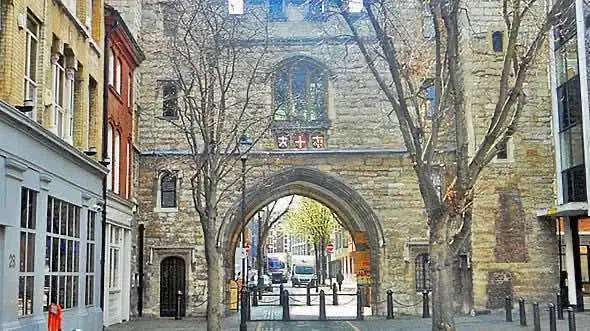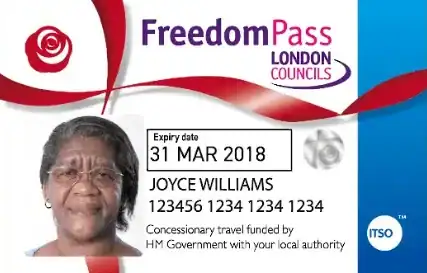
If you meet a St. John’s Ambulance man today then it will probably be at the empty end of a church fete – the deserted end where they put all the rent-a-toilets and first aid tables. They’ll put a plaster on your knee, dab a bit of TCP on a bee sting if you get stung, slap you about a bit if you feint in the summer sun, it’s all simple stuff like that.
But if you met them 1,000 years ago then it would have been a totally different story because they started out as doctor monks in Jerusalem, caring for all the pilgrims who came across from medieval Europe. Once the Crusaders captured the city they morphed into fighting monks (a bit like the Knights Templar), and called themselves the Knights of the Order of St John of Jerusalem.
 Photo: londondrum.com
Photo: londondrum.comThe medieval Clerkenwell Priory
That’s where St. John’s Gate comes into the story, because this castle-like gatehouse was part of Clerkenwell Priory – their headquarters in England.
In 1292 the Muslims booted them out of the Holy Land and they upped sticks to Cyprus, then Rhodes, then Malta, where Napoleon finally finished off their foreign adventures. That would have been the end of their story except Queen Victoria gave them a Royal Charter to provide humanitarian aid again, and that’s how we know them today – from their first aid tables at the empty end of church fetes.
 Photo: londondrum.com
Photo: londondrum.comClerkenwell Priory didn’t last anywhere near as long as the Knights because it succumbed to Henry VIII’s Dissolution of the Monasteries in the 1530s. This imposing stone gatehouse is one of the only prominent pieces still standing and the first time you stumble across it you might think it’s a Victorian folly, or a piece of set dressing from a Robin Hood movie, but it was here in the 1550s when Bloody Mary was burning heretics down the road. It was here in 1666 when the Great Fire of London levelled everything up to Smithfield. It even saw off Hitler’s Blitz in 1940.
 Photo: londondrum.com
Photo: londondrum.com Photo: londondrum.com
Photo: londondrum.comInside the museum are three small rooms telling the story of the Order. They have a nice collection of old coins, books and bibles, cannonballs and a cannon barrel, and a few suits of chainmail armour. There are plenty of paintings as well. The last room concentrates on their modern day role as first aid volunteers.
 Photo: londondrum.com
Photo: londondrum.comThe Norman Priory church
Once you’ve seen inside the museum remember to have a little stroll down the road to Priory Church (it’s a totally separate building). The church itself is nothing much to look at because it was rebuilt after the war, but you’re not here for that… you’re here to see the creepy Norman crypt. It’s a very low vault with concrete arches that press down upon your head I’m not sure that I’d want to sit through a mass in it, but check out that tomb in the chamber on the left – isn’t that the most gruesome tomb you’ve ever seen in your life? Most people want their effigy to show them looking at their best, but this lady has shown her face as a starved skull, with ribs jutting through her chest like a famine victim.
 Photo: londondrum.com
Photo: londondrum.com Photo: londondrum.com
Photo: londondrum.comLet me sum it up like this: if you’re already interested in the Crusades then the museum is worth a quick visit, and the gatehouse is certainly worth a look if you’re already walking around Smithfield, but the museum’s not big enough to warrant a detour.
I also recommend… If you enjoy this then try Charterhouse (you can walk it in less than 3 mins). If you’re interested in the Crusades then don’t miss the Knights Templar’s Temple Church (… that’s the one that’s featured in the Da Vinci Code)
How to get to St. John’s Gate
| Fare zone | Cash | Oyster & Contactless | Travelcard | ||||
|---|---|---|---|---|---|---|---|
| Single fare | Single fare | Daily cap | One day | ||||
| Peak | Off-peak | Peak | Off-peak | Anytime | Off-peak | ||
| Bus (all zones) | n/a | £1.75 | £5.25 | £6 | |||
| Train (zone 1) | £7 | £2.90 | £2.80 | £8.90 | £8.90 | £16.60(zone 1-4) | £16.60(zone 1-6) |
| Train (zone 1-2) | £7 | £3.50 | £2.90 | £8.90 | £8.90 | ||
| Train (zone 1-3) | £7 | £3.80 | £3.10 | £10.50 | £10.50 | ||
| Train (zone 1-4) | £7 | £4.60 | £3.40 | £12.80 | £12.80 | ||
| Train (zone 1-5) | £7 | £5.20 | £3.60 | £15.30 | £15.30 | £23.60(zone 1-6) | |
| Train (zone 1-6) | £7 | £5.80* | £3.80* | £16.30 | £16.30 | ||
| * Journeys between zone 1 and Heathrow are always charged at the peak rate. Prices are correct as of | |||||||
 Twitter
Twitter Facebook
Facebook Bluesky
Bluesky WhatsApp
WhatsApp Email
Email




